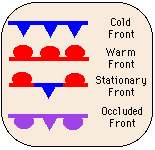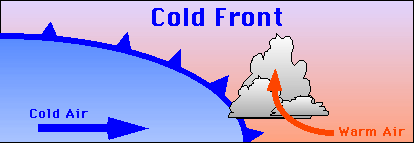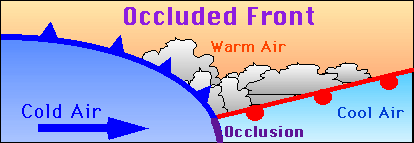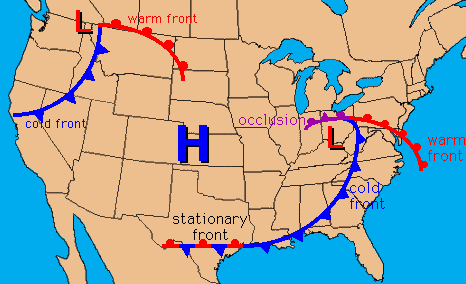
Fronts
Fronts are zones where two air masses with differing densities meet. The difference in density is due to either temperature differences, moisture differences, or both. There are four types of fronts: cold fronts, warm fronts, occluded fronts, and stationary fronts. They are each expressed on maps using the symbols at the right. The barbs on the lines (triangles and curves) point in the direction of frontal movement.
A cold front is the transition zone where a colder, drier air mass is replacing a warm, moist air mass. Across the frontal zone, there is a sharp temperature decrease, a sharp humidity decrease, and a shift in wind direction. Often, there are clouds and precipitation. Cold fronts often bring very severe weather. This is due to the fact that warm, moist air is less dense than cold, dry air. The warm, moist air is forced upward as the cold front moves in, causing thunderstorms to form. Notice that the leading edge of the cold front has a high angle, which can rapidly force warm, moist air aloft.

A warm front is the boundary zone between retreating cold air and the advancing warm air. Again, the warm air overrides the cooler air, forming clouds and precipitation. However, the weather is characterized by rain or showers, not storms. Because the slope of the warm front is not as steep as the cold front, showers form more gradually, preventing latent energy from reaching high altitudes. There is a temperature and humidity increase with the passage of a warm front.

Often, a cold front will travel faster than a warm front and will eventually catch up and overtake the warm front. The boundary created is called an occluded front or an occlusion. Here, the layer of warm air is lifted above both layers of cold air. Preceeding the occluded front would be showers typical of a warm front. But as the front gets closer, more stormy-like conditions may prevail.

A stationary front is a boundary between two air masses that are not moving. The weather along the front will vary from clear to showery, depending on the air masses involved.





Developed by
 The Shodor
Education Foundation, Inc.
The Shodor
Education Foundation, Inc.
Copyright © 1996






 The Shodor
Education Foundation, Inc.
The Shodor
Education Foundation, Inc.